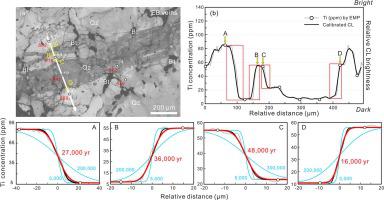Ore Geology Reviews ( IF 3.2 ) Pub Date : 2021-09-11 , DOI: 10.1016/j.oregeorev.2021.104459 Qi Chen 1 , Changming Wang 1 , Leon Bagas 2 , Zhaochong Zhang 1 , Bin Du 1, 3

|
Accurate determination of the time scales of multiple magmatic-hydrothermal pulses is a critical and difficult problem, which can provide information needed to better constrain the genesis of porphyry deposits. Here, we take advantage of zircon U-Pb dating and improvements in the field of diffusion chronology to determine time scales of multistage magma-related hydrothermal events at the giant Yulong porphyry Cu-Mo deposit in eastern Tibet. New LA-ICP-MS zircon U-Pb data showing that the mineralised Yulong porphyry crystallised at ca. 41 Ma, with the emplacement of the subeconomic Ganlongla intrusion at ca. 41 Ma, indicating a contemporaneous magmatism and mineralisation. Quartz from porphyry and hydrothermal veins exhibits cathodoluminescence (CL) images with a variety of brightness and textures, whereas trace element analyses show that the CL intensity is strongly related to the Ti contents of quartz. The Ti-in-quartz analyses of quartz precipitated in equilibrium conditions yield TitaniQ temperatures that agree with the temperatures calculated using independent thermometers. The sharpness of the Ti gradients observed in the CL images coupled with Ti diffusion modelling for different quartz generations indicate that the bulk of the mineralisation at Yulong formed in a short period of between 880,000 and 16,000 years. These data, together with available isotopic dating data, suggest that the mineralisation is coeval with the emplacement of the porphyries. Complex multi-stage hydrothermal stockwork veins and shorter time scales reveal that the individual magma and fluid pulses at Yulong formed rapidly within tens of thousands of years.











































 京公网安备 11010802027423号
京公网安备 11010802027423号